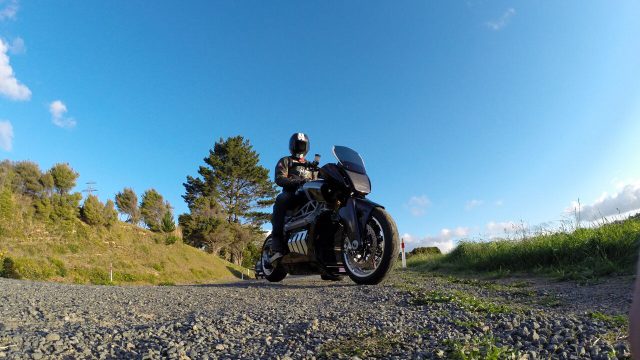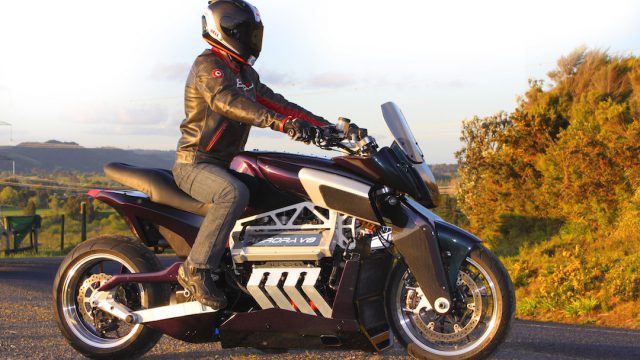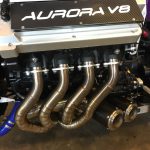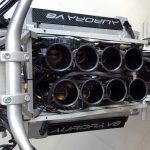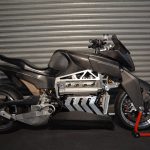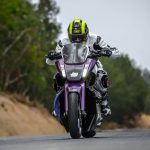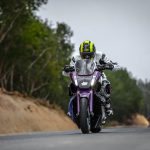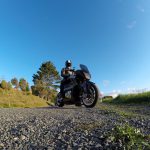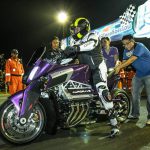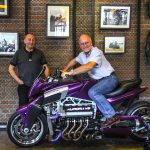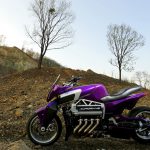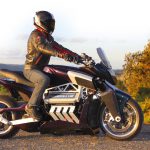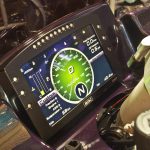Full inside story of the Australian-designed 2,575cc V8 sportbike
There must be something in the water, or maybe it’s those penal colony genes. But the fact is that nowhere else than in Australia do visionary engineers produce V8 motorcycles powered by their own design of such multi-cylinder motors, rather than concoct a Boss Hoss-style Chevrolet or other Detroit-sourced automotive transplant. Not only once – as with the various iterations of the Drysdale V8 produced by Melbourne’s Ian Drysdale over the past 20 years, ranging from his 750cc Superbike racer to 1000cc Bruiser muscle cruiser. And not even just twice, as with his neighbour Paul Maloney’s magnificent 1996cc 40-valve PGM-V8 which debuted two years ago, a two-wheeled Cosworth DFV producing 334 bhp at the rear wheel at 12,800 rpm, coupled with a hefty 214 Nm of torque at 9,500 revs – yet with a clutch light enough to work with a single finger, on a bike that’s a pussycat prowling round town at low speeds, before shaking off that disguise in a flash to become the Lion King of the highway once you show it an open road. For to complete a hat-trick of Australian amplitude, here making its debut on the world stage is the Aurora Hellfire V8, created from the ground up by the man who’s completing this trifecta of Aussie V8s with two wheels rather than four, former Australian Sidecar road racing champion and ex-Ford Motor Company engineer, Vincent Messina.
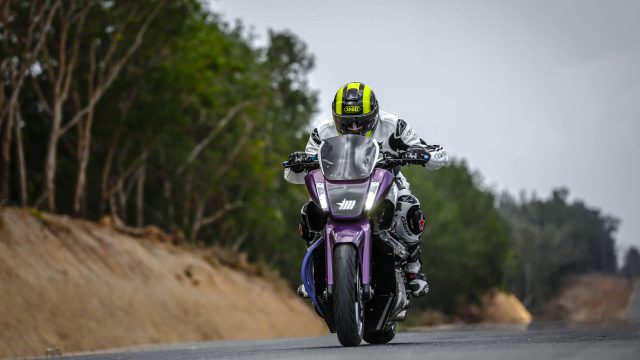
In fact, it must be the Yarra River water that’s responsible for this improbable confection of multi-cylinder motorcycles, for all three men – Drysdale, Maloney and Messina – were each Melbourne based when they created their cocktail of technical excess. But the Aurora V8 is taking a different path than its compatriot models to the customer marketplace, for after conceiving it in Australia and creating the 2.4-litre proof-of-concept prototype in New Zealand that made its global debut two years ago at the 2015 EICMA Milan Show, Messina is completing R&D of the 2,575cc 417-bhp 16-valve quad-cam production version of the Hellfire V8 in Thailand. He’s been resident in Bangkok for the past six years, and production is scheduled to begin there later next year in Chonburi, home to Triumph’s trio of Thai factories where until very recently the British firm’s smaller-capacity but still pretty monstrous 2.3-litre Rocket-3 was manufactured. And not far away is the Ducati plant assembling the Diavel cruiser that’s certain to be comprehensively out-muscled by the Hellfire motor of double the capacity, as it churns out a whopping 319Nm/235 lb-ft of torque at 7,000 rpm. After meeting him at EICMA, the chance to visit Vincent Messina at his base in downtown Bangkok, and examine the Aurora V8 up close and personal, uncovered a fascinating tale of endeavour and ingenuity.
“I worked for ten years in the Ford Motor Company in Victoria, before starting a business with my brother manufacturing dynamometers. and high quality test machines for calibration companies,” says Vincent.” But my partner Alison Scoullar also worked for Ford as a Mechanical Engineer, and she was asked to transfer to Thailand for them. This was in 2011, and we could already see that in Australia there was no future working in Automotive Engineering, and indeed all the car manufacturing plants there have now shut down. So we came over here and I loved this place straight away – the weather, the lifestyle, the people, and their love for motorcycles. Thailand is the biggest market in the whole of Asia for bikes over 400cc, so we settled down here very happily – though not for long. No sooner had I obtained my own work permit and business visa, than Ford decided they needed Alison in China, so she was transferred to Nanjing – and now I have to use Air Asia to commute to see her and our 10-year old daughter on a regular basis!”
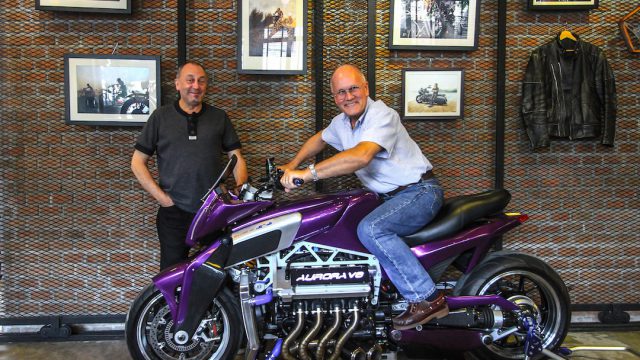
Alison Scoullar was also Messina’s partner in a different sphere, since the duo twice won the Australian Sidecar road racing title in the late 1990s, and finished second four times on rear-engined ‘worm’ outfits Vincent had designed and built himself, powered by self-tuned Kawasaki ZZR1200 motors. But from there to creating the Aurora Hellfire was a huge step. So how did the idea of building his own V8 bike come about?
“I’d got a bit bored with the sidecar, and being named Vincent I actually wanted a Vincent,” says Messina. “But they got so expensive that I thought, why spend $100,000 on a bike? It’d be better if I built my own – so that started the whole thought process. I’ve always spent a lot of time on the road, so riding long journeys in Australia gave me lots of time to think. I’d always wanted to build a V8 after visiting the Moto Guzzi factory museum, and I’d also had a long love affair with the Laverda V6. Initially the Aurora was supposed to be a V6, too, but it was hard to engineer and I thought the V8 would be easier, so we started on that in around 2004, while we were still living in Australia.”
Messina produced the first metal parts for his totally self-funded V8 project in 2006, and the complete engine came together the following year – but then he had to make it rideable. “I had a lot of help from a development company called Prototipo in NZ, and I was fortunate enough to meet a young guy through them called Nick Rogers. He was fresh out of University, with a head full of ideas, half of which might work, with the other half just dreams. But we instantly formed a bond and started working together. I’d do a drawing on CAD 2D and he’d put it into CAD 3D, and gradually the complete bike took shape. It dragged along for quite a while; mostly because of finances after my move to Bangkok, and then Prototipo got busy themselves. So I set ourselves a deadline whereby I booked us into the 2015 EICMA Milan Show one year ahead, and I told everyone the bike had to be finished on a certain date in order to be shipped to that. The absolute last day before it had to be on the airplane to Europe was the day the bike arrived in Thailand from NZ, so we just turned it around and sent it straight to Milan! That’s how tight it was.”
The Aurora Hellfire V8 duly made its global debut in a back corner of the 2015 EICMA Milan Show, without at that stage ever having been ridden, or indeed fired up. “I’d asked the organizers to put us in a good spot, reasoning that they’d like to have an all-new V8 motorcycle in a starring role – but instead we got dumped right at the back of a distant hall with hardly any light, right by the door they used to take out the trash,” says Vincent with a grimace. “But we’d got the bike finished, and on display, so we sent one of the young Thai girls Alison and I had there as models down to the front doors to make sure everyone with a camera came to the back to get a photo of the bike. Mission accomplished! So we got heaps of photo coverage, which was great, and crowd numbers were pretty good considering where we were – each day we caused a traffic jam with so many people milling around that they couldn’t get the rubbish out. Revenge was sweet! But of course, none of the locals could believe what they were seeing – quattrocentro cavalli, non e possibile!”
Back home in Bangkok after that the original proof-of-concept showbike was then finally dyno tested – see
for the promo video made soon afterwards. Since then, Messina and his men (and ladies, too) have been working on the pre-production version of the bike, which amongst other things will see the capacity nudge upwards to 2,575cc by dint of boring and stroking the original 80-degree V8 dry-sump motor to 86 x 55.4 mm. This means it’s no longer the doubled-up 83 x 55.4 mm Kawasaki ZX-12R that the 2,398cc debut version essentially was, building on Vincent’s experience with the big Kwacker motors in sidecar racing. But that wasn’t all. “We had an interesting conversation after Milan with a journalist who insisted he wanted to take the bike to a race track,” he says, “That instantly sent shivers up my spine, because while it ran as good as my Ducati Diavel on the street, I didn’t think the Aurora was ready for track use. So we went back to the drawing board and started looking at ground clearance. We moved the alternator from the left hand side and put it in between the cylinder vee, we went to a smaller water pump and dry sump air/oil separator on the right hand side, and made a new exhaust to wrap around it, and that gave us 55 degrees of lean angle. Then we started mapping the engine, and refining the engine management and handling. We’re almost there, now – another couple of months and we’ll be ready to start getting serious about gearing up for production.”
Unlike his fellow members of the Melbourne V8 mafia, Messina has positioned the crossplane-crank Aurora V8’s quad-cam 32-valve motor lengthways in the wheelbase, in which guise it removes the need for a chassis as such – everything else, suspension and wheels included, is hung off the engine. “Looks were the main reason for installing it that way, I guess,” admits Vincent. “But the whole concept was always to have an engine and gearbox arrangement that you could bolt bits on to.”
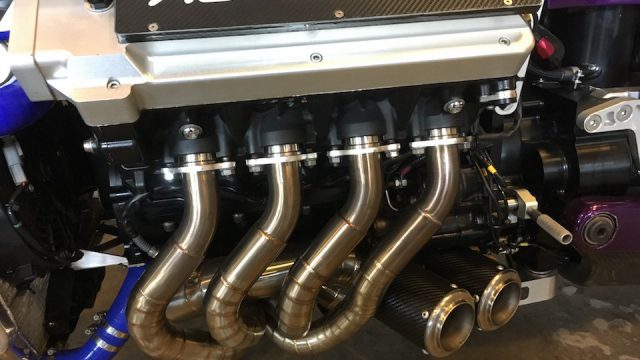
The liquid-cooled Aurora V8’s plain-bearing one-piece crankshaft was made by Prototipo in NZ, and carries billet steel conrods made in Argentina by Saenz. The three-ring Wiseco pistons from the USA deliver 12:1 compression running in the Nikasil-coated bores of the twin Kawasaki ZX-12R cylinder blocks, which are mounted on Messina’s own design of crankcase. The Kawasaki heads and camshafts fitted to the original 2.4-litre motor have been replaced by Aurora’s own, while the massive 46mm throttle bodies – eight of them, so no doubling up – with a single injector positioned in each body just above the butterfly, were made by Jenvey Dynamics in the UK, and are fitted with their own DC servo motors to provide a full RBW/ride-by-wire digital throttle. What’s more, they’re fully visible in operation beneath the illuminated perspex engine shroud which replaces the fuel tank – that’s 22-litres in size, and is positioned behind the air intake box and runs beneath the seat, with the eight-litre oil tank for the dry sump engine mounted above the motor itself, below the gearbox. “I always had this dream of doing what they did with old 1960s Ferrari F1 cars and Endurance racers,” says Vincent. “They’d have a see-through panel in the rear tail section where you could look down the intake stacks, and see the throttles working while they warmed it up in the paddock. I thought it’d be fantastic if people could do the same on my motorcycle!”
Inevitably for a Melbourne-conceived motorcycle, management of the Aurora’s multipoint EFI is taken care of by an M1 ECU from local experts MoTeC, which allows Messina to install his own riding mode programmes in it – Sport, Touring and Rain, plus one Custom option. MoTeC also furnished the C127 TFT dash which features 16 full colour integrated LEDs for use as shift lights, warning lights etc. The colour, function and intensity of each LED is programmable, allowing riders to develop their own personalised visual strategies. It also has basic data acquisition, and will allow future Aurora customers to be furnished with updated fuel maps etc. wirelessly or via the internet. 10-stage traction control comes as standard, and the wide-open powershifter which is clutchless in either direction can either be operated normally by foot, or via push buttons on the handlebar. The Aurora’s top speed is quoted as exceeding 340 kmh (211 mph), so it’s going to be interesting seeing it in action on a dragstrip!
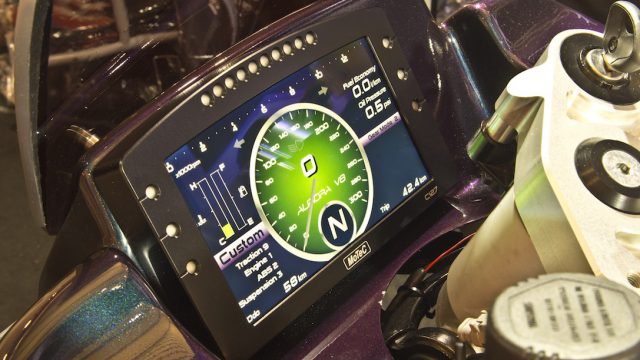
After starting out with 397 bhp in 2.4-litre guise, the 417bhp/311kW quoted for the 2.6-litre production Aurora V8 motor is a crankshaft figure, simply because they can’t get the rear wheel to stop spinning without dialling in heaps of traction control, which destroys the whole purpose of the test! Messina says that the power delivery is pretty flat from 9,000 rpm to safe revs of 11,500, but the engine will be limited to 9,500 rpm in customer guise. Transmission comes via a 5-speed Nova gearbox custom-made for the bike, but retaining the architecture of the original Kawasaki unit – although the Sigma oil-bath slipper clutch with carbon plates has been installed to counterotate relative to the crankshaft, thus substantially dialling out the gyroscopic issues inherent in most motorcycles with a lengthways positioned crankshaft, says Messina. “We started off with a 6-speed motorcycle gearbox off a ZX-12R Kawasaki, because we had a couple of these left over after we took the cylinder blocks off them for the V8,” says Messina. “But we took 6th gear off because we don’t need that many ratios, and instead used it to drive the drive shaft via a take-off to the left-hand side which runs the drive shift. This is housed within a carbon fibre swingarm with inbuilt cushdrive – the whole bike is only carbon fibre or aluminium, with no steel pipes whatsoever.” Dry weight is currently a claimed 265kg split 50/50% front and rear, so the same as a Hayabusa’s kerb weight fully fuelled, but without gas.
The Aurora’s ultra-lightweight adaptation of the Fior/Hossack front suspension shared with the new Brough Superior SS100 and BMW’s Duolever copy, consists of a carbon fibre wishbone fork, with twin articulated CF triangular links and billet alloy mechanism. This is essentially bolted to the front of the engine, and is controlled by the same type Öhlins Electronic TTX monoshock as used at the rear, that’s fully adjustable for preload and rebound damping in delivering a pretty huge 160mm of wheel travel at both ends. At the rear the Guzzi-style so-called Twin Link fabricated aluminium parallelogram swingarm pivots in the gearbox/flywheel housing, and offers 28% of anti-squat in operating the Öhlins shock via a bell-crank linkage similar to that used on Kenny Roberts’ 1981 500GP Yamaha OW60. Steering geometry is relatively conventional, with a 25º head angle and 100mm of trail, while the wheelbase isn’t excessive, considering the lengthways mounted engine, at 1600mm. Seat height is 820mm at present, and the Hellfire’s highly idiosyncratic looks come courtesy of noted Aussie designer Tim Cameron.
The forged aluminium Marchesini wheels currently fitted may be replaced according to customer choice by South African-made BST carbon fibre items, with an oversize 6.50in rear specially made by them for Aurora. Same thing with the brakes, with a choice of twin 330mm Brembo Supersport discs or same-size but much lighter Brake Tech CMC/ceramic matrix composite discs, in either case gripped by four-piston radially-mounted Brembo GP4RX calipers via a radial Brembo RCS master cylinder. There’s a comparable choice of materials and weight at the rear, and either Bosch or Continental ABS will be fitted as standard – Messina says he’s still evaluating which to go with, and Continental is currently being tested on the prototype. Michelin is currently the favoured tyre supplier, but customers can specify which brand they prefer.
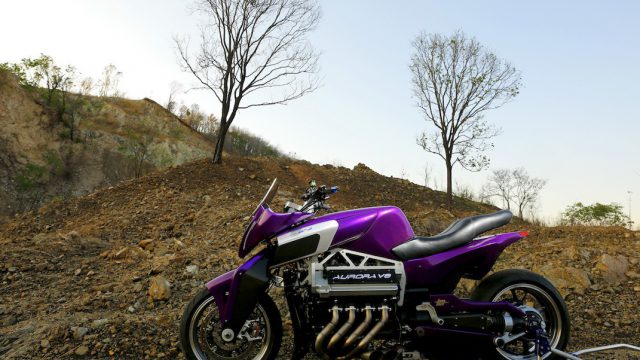
So now for the big question – how much will it cost to put yourself in that position, by joining the exclusive owners club of the world’s most powerful normally aspirated streetlegal motorcycle? Figure US$120-140K, says Vincent Messina, who claims to have already taken orders for what is a motorcycle with performance to match its undoubted visual presence. “I need to sell 10 bikes to make the first production run viable, and I have four firm orders, maybe five,” he says. “But the bike’s still in its ascendancy. We’re testing the bike constantly, and I need to finish sorting it out so I can throw a leg over it at any point in time, and ride it anywhere that I ride my Diavel, otherwise I’m kidding myself that something couldn’t go wrong, and I’d get a bad name. I don’t want that – I want our bikes to be seen as an investment, yet one you can actually ride. There’s enormous interest in the Aurora here in Thailand, and I plan to do some publicity events like going to the airport here in Pattaya and doing a straight line test against the Bugatti Veyron and H2R Kawasaki! Get those sorts of things on YouTube, and they become major hits with upwards of 15 million views. My assistant took a little 15-second sound and video clip when I was warming the V8 up at the office one morning, and she posted it on a Facebook page. Within five days it had 550,000 hits. See what I mean?”
“Developing the bike in Thailand has given me more time to work on the concept, and the issues. Just things like the gearbox took two years to work out – it’s got its own oil pump separate from the engine, so it doesn’t shed oil. The clutch spinning backwards to compensate for the gyroscopic forces of the crankshaft took quite a bit of time, same as the carbon clutch, the rear end’s multilink suspension, and the carbon fibre drive shaft housing. Plus, you can’t sell a motorcycle unless it sounds good – and sound was always one key thing. I wanted a V8 motorcycle that sounded like a Ferrari, and with the 80-degree vee it sounds like a very angry Ferrari, which is great! That’s why the exhaust pipes all exit on the same side of the bike, which is a nightmare to engineer, but gives you that sound you just can’t describe – it’s like a shriek when you rev it hard from low down. Mechanical music!”
